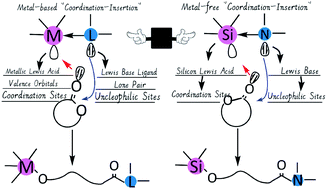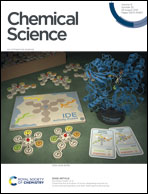Non-metal with metal behavior: metal-free coordination-insertion ring-opening polymerization†
Abstract
The “coordination-insertion” ring-opening polymerization (ROP) mechanism has so far been the monopoly of metal catalysts. In this work, we present a metal-free “coordination-insertion” ROP of trimethylene carbonate (TMC) and ε-caprolactone (ε-CL), as well as their sequential block copolymerization, with N-trimethylsilyl-bis (trifluoromethanesulfonyl)imide (TMSNTf2) as the non-metallic initiator/catalyst. TMSNTf2 was proposed to work through an unprecedented metal-free “coordination-insertion” mechanism, which involves the coordination of monomer to the Si atom of TMSNTf2, the nucleophilic attack of the –NTf2 group on the coordinated monomer, and the cleavage of the acyl–oxygen bond of the monomer. The proposed metal-free “coordination-insertion” ROP was studied by NMR, SEC, and MALDI-TOF analyses. In addition, the TMSNTf2-mediated ROP of TMC and ε-CL led to linear and cyclic polymers following two-stage first-order polymerization processes, as evidenced by structural analyses and kinetics study, which further demonstrated the metal-free “coordination-insertion” mechanism.

- This article is part of the themed collection: 2021 Chemical Science HOT Article Collection


 Please wait while we load your content...
Please wait while we load your content...